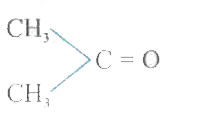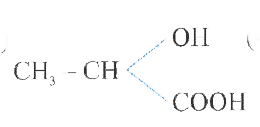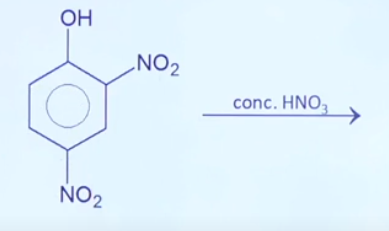Acetaldehyde on treatment with HCN forms a cyanohydrin. What will be the product if this cyanohydrin is further hydrolysed ?
CH3COOH


CH3CH2OH
The correct Answer is:C
To solve the question, we need to follow these steps:
Step 1: Understand the Reactants
We start with acetaldehyde, which has the chemical structure CH3CHO. Acetaldehyde is an aldehyde, and when it reacts with hydrogen cyanide (HCN), it will form a cyanohydrin.
Step 2: Reaction with HCN
In the presence of HCN, the cyanide ion (CN⁻) acts as a nucleophile and attacks the electrophilic carbon atom of the carbonyl group in acetaldehyde. This leads to the formation of a cyanohydrin.
The reaction can be represented as follows:
CH3CHO+HCN→CH3C(OH)(CN)
This product is known as 2-cyanoethanol.
Step 3: Hydrolysis of the Cyanohydrin
Next, we need to consider what happens when the cyanohydrin undergoes hydrolysis. Hydrolysis involves the addition of water (H2O) to the cyanohydrin, which will convert the cyano group (CN) into a carboxylic acid (COOH).
The hydrolysis reaction can be represented as follows:
CH3C(OH)(CN)+H2O→CH3C(OH)(COOH)
Step 4: Final Product
After hydrolysis, the cyanohydrin will yield the corresponding carboxylic acid. In this case, the product will be:
CH3COOH
which is acetic acid.
Conclusion
Thus, the final product after hydrolysis of the cyanohydrin formed from acetaldehyde and HCN is acetic acid (CH3COOH).
We start with acetaldehyde, which has the chemical structure CH3CHO. Acetaldehyde is an aldehyde, and when it reacts with hydrogen cyanide (HCN), it will form a cyanohydrin.
In the presence of HCN, the cyanide ion (CN⁻) acts as a nucleophile and attacks the electrophilic carbon atom of the carbonyl group in acetaldehyde. This leads to the formation of a cyanohydrin.
CH3CHO+HCN→CH3C(OH)(CN)
Next, we need to consider what happens when the cyanohydrin undergoes hydrolysis. Hydrolysis involves the addition of water (H2O) to the cyanohydrin, which will convert the cyano group (CN) into a carboxylic acid (COOH).
CH3C(OH)(CN)+H2O→CH3C(OH)(COOH)
After hydrolysis, the cyanohydrin will yield the corresponding carboxylic acid. In this case, the product will be:
CH3COOH
which is acetic acid.
Thus, the final product after hydrolysis of the cyanohydrin formed from acetaldehyde and HCN is acetic acid (CH3COOH).
Topper's Solved these Questions
- BOOK - NARAYNACHAPTER - ALDEHYDES, KETONES & CARBOXYLIC ACIDSEXERCISE - EXERCISE -I (H.W.)15videos
ALDEHYDES, KETONES & CARBOXYLIC ACIDS
- BOOK - NARAYNACHAPTER - ALDEHYDES, KETONES & CARBOXYLIC ACIDSEXERCISE - EXERCISE -II (C.W.)25videos
ALDEHYDES, KETONES & CARBOXYLIC ACIDS
- BOOK - NARAYNACHAPTER - ALDEHYDES, KETONES & CARBOXYLIC ACIDSEXERCISE - C.U.Q60videos
ALDEHYDES, KETONES & CARBOXYLIC ACIDS
- BOOK - NARAYNACHAPTER - ALCOHOLS, ETHERS, PHENOLEXERCISE - Assertion Reaosn10videos
ALCOHOLS, ETHERS, PHENOL
- BOOK - NARAYNACHAPTER - AMINES & DIAZO COMPOUNDSEXERCISE - Subjective type Q.13videos
AMINES & DIAZO COMPOUNDS
Similar Questions
Knowledge Check
- Question 1 - Select One
An aldehyde reacts with KCN to form cyanohydrin. In this reaction
ACN− acts as nucleophile and does nucleophilic additionBCN− acts as nucleophile and does electrophilic additionCCN− acts as an electrophilic and does electrophilic additionDCN− acts as nuclcophile and does nucleophile substitution - Question 2 - Select One
The prdouct/s formed when diborane is hydrolysed is/are
AB2O3 and H3BO3BB2O3 onlyCH3BO3 and H2DH3BO3 only - Question 3 - Select One
What would be the product when acetaldehyde reacts with HCN and the product is further hydrolysed-
A2-Hydroxy propanoic acidBLactic acidCBoth A & BDNone of these
Acetaldehyde and acetone react with HCN to form corresponding __________.
View SolutionWhat is the product when acetylene reacts with HCN
View SolutionChlorobenzene on treatment with acetyl chloride and anhydrous AlCl3 the major product formed will be
View SolutionOn treatment of acetone with dilute Ba(OH)2, the product formed is:
View SolutionA carbonyl compound gives a positive lodoform test but but does not reduce Tollen's reagent or Fehling's solution. It forms a cyanohydrin with HCN, which on hydrolysis gives a hydroxy acid with a methyl side chain. The compound :-
View Solution


